旅游英语汉译英ppt
20161014级旅游英语.

Unit 1一.英汉互译。
1、接机牌代理、中介2、旅行社社旗国际的3、旅游团团体4、领队服务、公共机构5、打扰了,请问领导人6、散客宾馆、酒店7、导游证真的,确实8、CTS 向前的、向将来9、CYTS 相信、认为10、CITS 办理、设法对付二.判断。
1.When you are going to meet the tour group, you cann’t be late for 20minutes,because there is a tour leader.2.As a tour guide, you need carry Welcome Board and anything else about the guestswhen you are meeting them.3.As a tour guide, you needn’t to get everything ready beforehand when you take theguests to the hotel.4.You only meet the tour leader when you are meeting a tour group.5.When you are going to meet a tour group, you need know their time of arrival.三.选词填空。
meet, individual traveler, in very safe hands, on behalf of, pleasureexcuse me, a tour guide, welcome speech ,welcome to, luggage1.It’s my to be your tour guide in China.2.Beijing!3.Is that his to his first tourist?4.Don’t worry! He is here. Y ou are .5.our CITS, I’d like to extend a warm welcome to you all.6.Please be here and will meet you.7.Is this all your ?8.Zhang lin will the tour group at the airport. 9., are you John?10.Xiao hua will be the tour guide of .四.补全对话。
旅游英语汉译英

Translation Principles of Tourism English
• Accuracy principle: The translation of tourism English must be accurate and error free, without ambiguity or misleading tourists.
03
Promoting the development of the tourism industry: Accurate and vivid translation of tourism English can help attract more international tourists and promote the prosperity and development of the tourism industry.
Translation of tourist maps01 02 03来自Map elements
Accurately translate various elements on the map, including place names, roads, rivers, mountains, etc., to ensure that readers can accurately find their destination.
Maintain the original style
Try to maintain the language style and expression of the original text as much as possible, so that readers can better understand the characteristics of the scenic spot.
T31 旅游英语和翻译
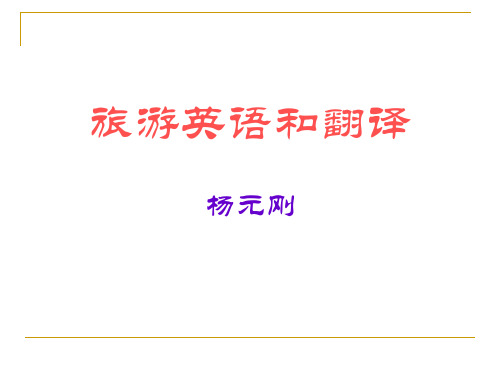
杨元刚
每课一句:Proverbs and Sayings
好词天天记
传销 pyramid-selling; multi-level marketing 创业园 high-tech business incubator; pioneer park 促进区域协调发展 promoting the coordinated development of all regions 促进全球经济一体化 foster integration with the global economy 粗加工产品 rough-wrought product 磁悬浮列车 Maglev train (magnetically levitated train), magnetic suspension train
外国人很理性,对数字概念很清晰。七大洲:Asia, Europe, Africa, South America, North America, Australia, Antarctic. 改为:A warm welcome for our overseas friends.
例3:温泉旅游度假区是您的投资宝地。 Wenquan Tourist & Holiday-spending Area is a valuable place for your investment. Wenquan Tourist & Holiday Resort is a promising land f or investment. a promising land: Bible, Moses, Exodus, Canaan. flow with milk and honey.
【精品】旅游翻译译例及翻译技巧(句子处理)
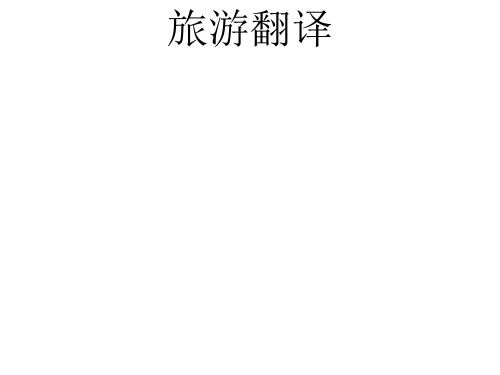
7)乐山水光山色独特,地理环境优 越,素有“绿杨夹岸水平铺”之 称,举行龙舟竞渡得天独厚。 (中国翻译《乐山龙舟会》) Famous for its “tranquil river fringed with rich vegetation”, Leshan in Sichuan Province has the ideal setting for its Dragon Boat Festival.
5)西湖如镜面,千峰凝翠,洞壑幽深, 风光绮丽。 The West Lake is like a mirror, embellished all around with green hills and deep caves of enchanting beauty.
6)河面各只彩船上无数五颜六色的 霓虹灯、日光灯齐放光华,闪烁迷 离,和水中倒影连成一片。漂灯点 缀河面,似万点繁星坠落人间。 These myriad-lighted boats become a riot of color which blend most subtly with colors from the river’s reflected surface.
Covered by groves of olive, lemon and pine trees, the island is cool, green and shady, and, in the spring is a fragrant mass of blossoms.
岛上绿树葱茏,果林成荫,一 丛接一丛的橄榄树、柠檬树、和松 树覆盖全岛,环境凉爽宜人。一到 春天,这遍岛花果成片开放,香气 袭人。
The island, covered by groves of olive, lemon and pine trees, is overgrown with a green and shady forest filled with cool air. When in spring, all flowers and fruits in the forest are blooming in mass with a striking fragrance over the island.
旅游英语ppt课件图片
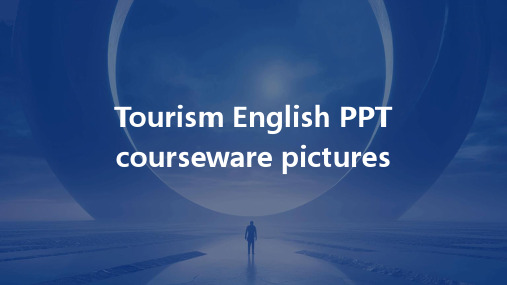
Pay attention to payment security
When using payment tools, pay attention to the surrounding environment to avoid disclosing personal information or passwords.
Leisure activities
01
Introduce various leisure activities such as SPA, massage, gym, etc., and provide English expressions.
Entertainment programs
02
Provide English entertainment program recommendations, such as concerts, dramas, movies, etc., to help learners enrich their travel life.
Detailed description
Natural scenery is one of the important attractions of tourism, such as magnificent mountains and rivers, clear lakes, beautiful beaches, and dense forests. These natural landscapes not only provide beautiful scenery, but also provide tourists with opportunities to get close to nature and experience its wonders and beauty.
旅游英语 苏静

总体原则
浓缩 ,翻译中往往为适合读者的需要增加或删 减信息。 汉语往往融情于景,注重言辞华美,句式 工整,用夸张,排比,对偶,比喻等等手 法 (说明文体除外)。英文倾向物我分离 ,写实,具体,客观情形的再现。汉译英 的过程中要向英文的风格靠拢。 最忌“对号入座”,死译硬译。
旅游翻译功能论
旅游翻译的两个目的 传递信息(informative)/诱导行动 (appellative) 旅游翻译注重的应是原文与译文间信息内容和文体功能的 对等,而不是语言形式上的对应,更不是展示原语言文化 异质性的场所。 这类功能的核心在于“读者层”, 使读者“完全不觉得在 读译文” 为了实现译文的功能,译者有理由对某些原文信息进行调 整和改写。(In order to be functional this part of the text would require a fair amount of rewriting)!
旅游资料的翻译方法
音译法与音意兼译法 意译法 增译法 删减法 创造性翻译
纯中国元素的处理(增译)
历史事件的发生年代,名人的生卒年代, 身份,历史贡献,名胜具体位置,人名, 地名,物品名,官阶名等确切含义。 清朝乾隆年间,扬州早已是一个兴旺发达 的城市了。 During the reign of Emperor Qianlong (1736-1795) of the Qing Dynasty (16441911), Yangzhou was already a prosperous city.
英文景点介绍风格一瞥
Welcome to Grand Canyon National Park. A powerful and inspiring landscape, the Grand Canyon overwhelms our senses through its immense size;277 river miles (446km) long,up to 18 miles (29km) wide ,and a mile (1.6km) deep.
大学英语六级汉译英翻译话题——旅游
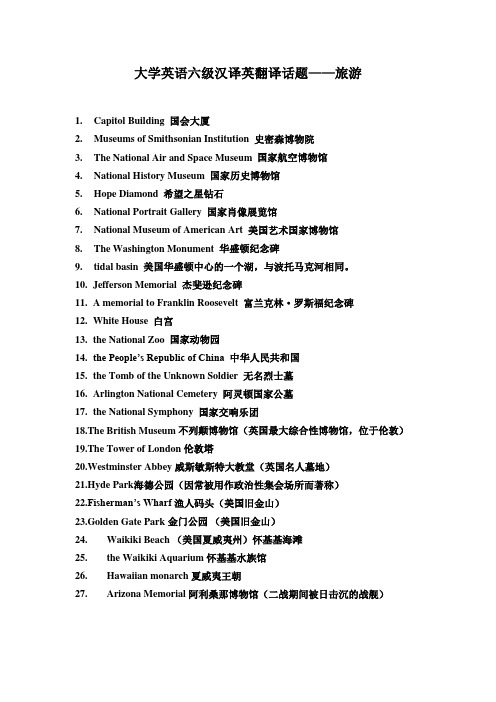
大学英语六级汉译英翻译话题——旅游1.Capitol Building 国会大厦2.Museums of Smithsonian Institution 史密森博物院3.The National Air and Space Museum 国家航空博物馆4.National History Museum 国家历史博物馆5.Hope Diamond 希望之星钻石6.National Portrait Gallery 国家肖像展览馆7.National Museum of American Art 美国艺术国家博物馆8.The Washington Monument 华盛顿纪念碑9.tidal basin 美国华盛顿中心的一个湖,与波托马克河相同。
10.Jefferson Memorial 杰斐逊纪念碑11. A memorial to Franklin Roosevelt 富兰克林·罗斯福纪念碑12.White House 白宫13.the National Zoo 国家动物园14.the People’s Republic of China 中华人民共和国15.the Tomb of the Unknown Soldier 无名烈士墓16.Arlington National Cemetery 阿灵顿国家公墓17.the National Symphony 国家交响乐团18.The British Museum 不列颠博物馆(英国最大综合性博物馆,位于伦敦)19.The Tower of London 伦敦塔20.Westminster Abbey 威斯敏斯特大教堂(英国名人墓地)21.Hyde Park海德公园(因常被用作政治性集会场所而著称)22.Fisherman’s Wharf 渔人码头(美国旧金山)23.Golden Gate Park 金门公园(美国旧金山)24. Waikiki Beach (美国夏威夷州)怀基基海滩25. the Waikiki Aquarium 怀基基水族馆26. Hawaiian monarch 夏威夷王朝27. Arizona Memorial 阿利桑那博物馆(二战期间被日击沉的战舰)1.你认为跟团旅游怎么样?What do you think of package holiday?2.他们通常很便宜,但是和一群吵闹的人们在一起吃盒饭不是我理想的假日。
旅游英语
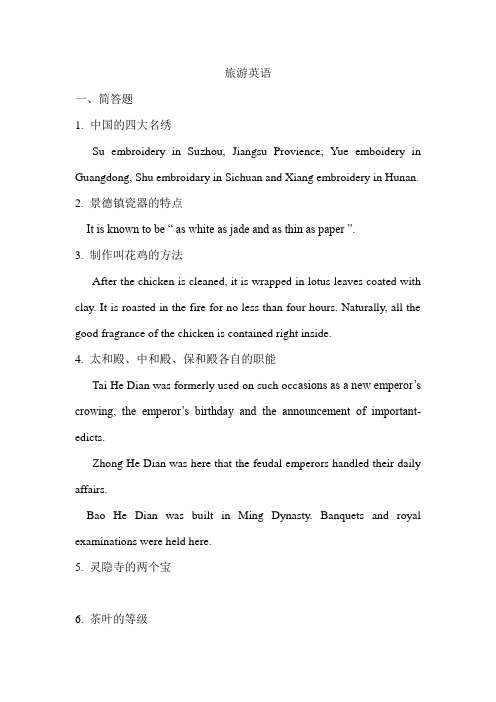
旅游英语一、简答题1.中国的四大名绣Su embroidery in Suzhou, Jiangsu Provience; Yue emboidery in Guangdong, Shu embroidary in Sichuan and Xiang embroidery in Hunan.2. 景德镇瓷器的特点It is known to be “ as white as jade and as thin as paper ”.3. 制作叫花鸡的方法After the chicken is cleaned, it is wrapped in lotus leaves coated with clay. It is roasted in the fire for no less than four hours. Naturally, all the good fragrance of the chicken is contained right inside.4. 太和殿、中和殿、保和殿各自的职能Tai He Dian was formerly used on such occ asions as a new emperor’s crowing, the emperor’s birthday and the announcement of important- edicts.Zhong He Dian was here that the feudal emperors handled their daily affairs.Bao He Dian was built in Ming Dynasty. Banquets and royal examinations were held here.5. 灵隐寺的两个宝6. 茶叶的等级7. 文房四宝The Chinese writing brush, the Chinese ink, the Chinese writing paper and the Chinese ink slab/stone.8. 简述黄浦江Huangpu River rises in Jiaxing County,Zhejiang Province.It runs through the city proper of Shanghai to meet the Changjiang River at Wusong,totaling 80 kilometers long with an average width of 400 meters.9. 赞美苏杭的一句话Up in heaven there is paradise, down on Earth there are Suzhou and Hangzhou.10. 列出一张菜单Assorted cold dish, roast Beijing duck, mushroom with green cabbage, sweet-sour pork, vegetable soup, Dongpo pork, shrimps with Longjing tea leaves, Sweet and sour West Lake Fish, beggar’s chicken, shredded beef in oyster oil, a chicken and mushroom soup, beef tendon, roast duck, spiced beef, fish aspic, dried tofu...什锦冷菜,北京烤鸭,冬菇菜心,古老肉,蔬菜汤,东坡肉,龙井虾仁,西湖醋鱼,叫花鸡,蚝油牛肉,小鸡炖蘑菇,美味牛筋,明炉烧鸭,五香牛肉,水晶鱼冻,素鸭...二、中译英1.我代表中国国际旅行社和我们的司机,刘先生,想想你们所有人表示我们最热烈的欢迎。
旅游英语课件-Tourism

Unit1 What is Tourism?When we think of tourism; we think primarily of people who are visiting a particular place for sightseeing, visiting friends and relatives, taking a vacation, and having a good time. They may spend their leisure time engaging in various sports, sunbathing, talking, singing, taking rides, touring, reading, or simply enjoying the environment. If we consider the subject further, we may include in our definition of tourism people who are participating in a convention, a business conference, or some other kind of business or professional activity, as well as those who are taking a study tour under an expert guide or doing some kind of scientific research or study.These visitors use all forms of transportation, from hiking in a wilderness park to flying in a jet to an exciting city. Transportation can include taking a chairlift up a Colorado mountainside or standing at the rail of a cruise ship looking across the blue Caribbean. Whether people travel by one of these means or by car, motorcoach, camper, train, taxi, motorbike, or bicycle, they are taking a trip and thus are engaging in tourism.Any attempt to define tourism and to describe its scope fully must consider the various groups that participate in and are affected by this industry. Their perspectives are vital to the development of a comprehensive definition. Four different perspectives of tourism can be identified:1. The tourist. The tourist seeks various psychic and physical experiences and satisfactions. The nature of these will largely determine the destinations chosen and the activities enjoyed.2. The businesses providing tourist goods and services. Business people see tourism as an opportunity to make a profit by supplying the goods and services that the tourist market demands.3. The government of the host community or area. Politicians view tourism as a wealth factor in the economy of their jurisdictions. Their perspective is related to the incomes their citizens can earn from this business. Politicians also consider the foreign exchange receipts from international tourism as well as the tax receipts collected from tourist expenditures, either directly or indirectly.4. The host community. Local people usually see tourism as a cultural and employment factor. Of importance to their group, for example, is the effect of the interaction between large numbers of international visitors and residents. This effect ma be beneficial of harmful, or both.Thus, tourism may be defined as the sum of the phenomena and relationships arising from the interaction of tourists, business suppliers, host governments, and host communities in the process of attracting and hosting these tourists and other visitors.Tourism is a composite of activities, services, and industries that delivers a travel experience: transportation, accommodations, eating and drinking establishments, shops, entertainment, activity facilities, and other hospitality services available for individuals or groups that are traveling away from home. It encompasses all providers of visitor and visitor-related services. Tourism is the entire world industry of travel, hotels, transportation, and all other components, including promotion, that serves the needs and wants of travelers. Finally, tourism is the sum total of tourist expenditures within the borders of a nation or a political subdivision or a transportation-centered economic area of contiguous states or nations. This economic concept also considers the income multiplier of these tourist expenditures.One has only to consider the multidimensional aspects of tourism and its interactions with other activities to understand why it is difficult to come up with a meaningful definition that will be universally accepted. Each of the many definitions that have arisen is aimed at fitting a special situation and solving an immediate problem, and the lack of uniform definitions has hampered study of tourism as discipline. Development of a field depends on (1) uniform definitions, (2) description, (3)analysis, (4) predictions, and (5) control.Modern tourism is a discipline that has only recently attracted the attention of scholars from many fields. The majority of studies have been conducted for special purposes and have used narrow operationaldefinitions to suit particular needs of researchers or government officials; these studies have got encompassed a systems approach. Consequently, many definitions of “tourism” and “the tourist” are based on distance traveled, the length of time spent, and the purpose of the trip. This makes it difficult to gather statistical information that scholars can use to develop a database, describe the tourism phenomenon, and do analyes. The problem is not trivial. It has been tackled by a number of august bodies over the years, including the League of Nations, the united Nations, the World Tourism Organization (WTO), the Organization for Economic Cooperation and Development (OECD),the National Tourism Resources Review Commission, and the U.S. Senate’s National Tourism Policy Study.World Tourism OrganizationThe international Conference of Travel and Tourism Statistics convened by the World Tourism Organization (WTO) in Ottawa, Canada, in 1991 reviewed, updated, and expanded on the work of earlier international groups. The ottawa Conference made some fundamental recommendations of definitions of tourism, travelers and tourists. The United Nations Statistical Commission adopted WTO’ recommendations on tourism statistics on March 4, 1993.TourismWTO has taken the concept of tourism beyond a stereotypical image of “h oliday-making.” The officially accepted definition is:Tourism comprises the activities of persons travelin to and staying in places outside their usual environment for not more than one consecutive year for leisure, business and other purposes.” The term usual envi-ronment is intended to exclude trips within the area of usual residence and frequent and regular trips between the domicile and the workplace and other community trips of a routine character.1. International tourism:a. Inbound tourism: visits to a country by nonresidents.b. Out bound tourism: visits by residents of a country to another country.2. Internal tourism: visits by residents of a country to their own country.3. Domestic tourism: internal tourism plus inbound tourism (the tourism market of accommodation facilities and attractions within a country).4.National tourism: Internal tourism plus outbound tourism (the resident tourism market for travel agents and airlines).Traveler Terminology for International TourismUnderlying the forego ing conceptualization of tourism is the overall concept of traveler, defined as “any person on a trip between two or more countries or between twoor more localities within his/her country of usual residence.” All types of travelers engaged in tourism are d escribed as visitors, a term that constitutes the basicconcept of the entire system of tourism statistics. Visitors are persons who travel to a country other than the one in which they generally reside for a period not exceeding 12 months, whose main purpose is other than the exercise of an activity remunerated from within the place visited. Visitors are subdivided into two categories:1. Same-day visitors: visitors who do not spend the night in a collective or private accommodation in the country visited: for example, a cruise ship passenger spending four hours in a port.2. Tourists: Visitors who stay in the country visited for at least one night: for example, a visitor on a two-week vacation.There are many purposes for a visit, notably pleasure, business, and other purposes, such as family reasons, health, and transit.Wordschairlift an apparatus which carries people up and sown steep slopes in chairs thathang from a moving wire 升降椅;空中缆椅camper a motor vehicle big enough to live in when on holiday, use. Havingcooking equipment and beds in the back part 野营车motorbike a motorcycle 摩托车psychic of the mind as opposed to the body精神上的jurisdiction the right to use the power of an official body, esp. in order to makedecisions on questions of law 管辖权;司法权,审判权composite something made up of different parts or materials 混合物,合成物encompass to include or be concerned with (a wide range of activities, subjects,ideas) 包含,包括;涉及subdivision the act of dividing something that has already been divided, or the partsthat result from doing this 再分,细分contiguous (to, with) touching, next (to); having a shared borde(正式)接触着的,接近的;接壤的multidimensional 多维的hamper to cause difficulty in movement or activity 阻碍,妨碍;牵制trivial of little worth or importance 琐碎的,没有价值的august lit noble and grand 威严的;高贵的convene to call (a group of people, committee) to meet 召集(会议);召集开会stereotypical as in an overly simple picture or opinion of person, group, or thing老套的,旧框框的consecutive following in regular unbroken order 连续的,连贯的domicile formal or law a person’s home; the place where a person lives or isconsidered to live for official purposes[法]户籍,正式居住地,信处workplace the room r building in which workers perform their work工作场所;工厂;车间inbound AmE incoming; inward bound 进来的outbound mowing sway from the speaker or the starting point 外出的,离开出发点underlie to be a hidden meaning or cause of 位于……之下;成为……基础foregoing (the one) that has been mentioned 前面的(事物),刚提到的(事物)conceptualization something that form a concept or concepts of概念化remunerate to reward; pay (someone) for work or trouble(正式)给……报酬;补偿transit the going or moving of people or goods from one place to another通行;过境Additional ReadingText A Mass TourismThe Historical SettingTourism harks back to the conquest of Alexander the Great (356-323BC) and the subsequent development of the Hellenistic urban system. It is argued that tourism requires both large claustrophobic cities and themeans to escape from them, both of which were present in Greece during this period.Within modern times, the notion of tourism is closely linked to the idea of the “Grand Tour”, which spanned the 16th to 19th Centuries. The Grand Tour is a “tour of certain cities in Western Europe undertaken primarily, but not exclusively, for education and pleasure”. This later era of grand tourism was typified by long, expensive, “classical” and “romantic” visits, mainly by the British aristocracy, to France, Italy, Germany, Switzerland and the Low Countries. Over time, and with the rise of the middle professional class, the Grand Tour was patronized by a wider segment of the population. Nonetheless, only 3%~4% of the Population represented the nucleus from which Grand Tourists might have be drawn. The golden age of the Grand Tour was the 18th Century, particularly the 30 years before the outbreak of the French Revolution in 1789. By the 1830s, the length of the Grand Tour fell from an average of 40 months in the mid-16th Century to an average of only 4 months.The growth of tourism to “mass” proportions as it is known today, has its fo undation in several timely innovations: technologically in the field of transportation; and in the existence of a critical facilitating force, entrepreneurship-in the person of Thomas Cook.In 1815, 1 year after the Battle of Waterloo ended the Napoleonic wars, the first channel crossing by steamer was made (the site of the battle itself becoming a major tourist attraction). By 1812, a regular service was operated between the ports of Dover and Calais. In 1828 the first railways were laid in France and Austria, and in 1844 the railway reached Switzerland. “This revolution in Transport technology and the low cost, speed and efficiency that it provided, led to an immediate expansion of European tourism.”Complementing transportation technology was the existenc e of entrepreneurial talent, “initiative” and “organizing genius” in the person of Thomas Cook. “His originality lay in his methods, his almost infinite capacity for taking trouble, his acute sense of the needs of his clients, his power of invention and his bold imagination” (Young, 1973). It has been written that “the father of modern tourism was unquestionable Thomas Cook” (English, 1986). “Cook was the perfect entrepreneur, a brilliant opportunist, quick to sense the need of his clientele…” (Turner and A sh, 1975). He was a true Schumpeterian entrepreneur-“a leader, a disturber of the peace”, who had the initiative, authority, foresight, and intuition and psyche to carry out innovations.Thomas Cook organized travel on a scale that had never been seen before. He heralded an era of organized, large-scale, relatively cheap tourism spread across national, regional and international destinations. If Europe had the “hot spots” for the Grand Tourists, the opening of the Far East, India and America, were the hallm arks of the Cook era. Until the early 1860s, Britain remained the main field of Cook’s activities; in 1862 he moved into Europe; he moved into America in 1866; took his first round-the-world trip in 1872; reached India and the Far East by the 1880s; and the first Cook hotel was established at Luxor (Egypt) in 1877.In 1862, the first true package tours were provided by Cook-all the details of transport and accommodation were pre-arranged for tourists who were, generally, of modest means. Spurred on by his example and the profits made by this entrepreneur, many imitators entered the fray. Turner and Ash write, for example, that ‘it was not long before his example was imitated; in 1863, the Stangen Travel Agency was established in Breslau. Stangen soon moved his center of operation to Berlin and became a successful rival to Cook’ (Tuner and Ash, 1975). By 19th –Century advances in transport technology, Thomas Cook and Son had effected a revolution in tourism by the end of the century. No longer the preserve of the wealth and the leisured, tourism was now an industry. While an average of 257 people per annum took part in Grand tourism during the 1547-1840 period (Towner, 1985), Cook had taken 20000 people to the Paris Exhibition of 1879-such was the magnitude of his entrepreneurial prowess.Despite the leaps and bounds that the industry experienced, tourism, until the 1930s, was still a matter of trains, boast and coaches. Travel by water transportation was a very important form of tourism during the1920s and 1930s. The ships themselves were a form of floating hotel, where the act of travel was equated with tourism. Travel was seen as an end in itself. As if the industry has gone full circle, today, cruise tourism is one of the fastest growing segments of the international tourism industry.It was in 1950 that the first package holiday built around air transport was organized. This was undertaken by Vladimir Raitz, a Russian émigré educated at the London School of Economics. His successful company, Horizon Holidays (now merged with Thomson, the largest UK operator) was one of the top three tour operators in Britain. By the 1960s, the package holiday business began to use air transport in a major way as Raitz’s competitors, spurred on by his success also began using the aircraft.Still, foreign travel in the 1930s remained a luxury commodity within the reach of only a privileged few having both plenty of free time and considerable purchasing power. This picture was to change when, coupled with post-war peace and prosperity, came innovations in aircraft technology and changes in labor legislation, which provided paid holidays, and the development of the package tour. Aided by these innovations, mass tourism had arrived.Mass Tourism DefinedMass tourism is a phenomenon of large-scale packaging of standardized leisure services at fixed prices for sale to a mass clientele. Mass tourism refers to key characteristics that the international tourism industry displayed during the 1960s, 1970s, and 1980s. Mass tourism exists if the following conditions hold.1. The holiday is standardized, rigidly packaged and inflexible, no part of the holiday could be altered except by paying higher prices.2. The holiday is produced through the mass replication of identical units, with scale economies as the driving force.3. The holiday is mass marketed to an undifferentiated clientele.4. The holiday is consumed en masse, with a lack of consideration by tourists for local norms, culture, people or the environments of tourist-receiving destinations.Standardization and rigidity are very clear characteristics of package tours offered on a large scale. An inclusive charter tour provides the same level of transportation, accommodation, meal and transfer services to all the clients who pay the same price, visit the same sun destination, sunbathe on the same beaches, sleep in the same high-rise hotels and in the same type of beds, read the same tourist brochures, visit the same sites, stay the same length of time, take the same kinds of photographs and even buy the same souvenirs.Within the confines of mass, standardized and rigidly packaged tourism, choice, individuality, personalized services and flexibility are just not possible (or where possible, it is at horrendous prices compared with the package price). There is little place within mass tourism for the individual who wishes to be different from the crows, who wishes to use different accommodation or participate in different holiday activities. It is true that many tourists have avoided the ¹mass¹tourist holidays and many have used the relatively cheap services of mass tourism as launching pads for their own vacations. However, in the 1960s and the 1970s, these were the exceptions rather than the common trend.Mass tourism certainly had its time and place. Today the tourism industry is in crisis. Mass tourism is no longer best practice. Conditions the gave birth to it –the frame conditions, consumers, technology, production and management practices-are themselves changing. Understanding how mass tourism came about and why it was best practice at the time are key to understanding why international tourism industry is being transformed and the shape that the new best practice is taking.Text B the Implications of New TourismNew tourism will change the boundaries of the tourism industry and radically alter the position ofindustry players. Players closest to consumers (e.g. travel agents, hotels, cruise ships) and those in control of the industry’s information (e.g. those that own CRSs) are expect ed to gain. CRSs will increasingly become the flexible alternative to pre-packaged holidays offered by tour operators. The role of tour operators is expected to decline in importance. It is no longer relevant whether a company is an airline, a travel agent, hotel or tour operator. What becomes more relevant are the activities along the value chain that they control.These changes imply a radical transformation of the opportunities available to the various players in the tourism industry. New functions and demands will emerge (e.g. quality control, flexible holidays). While at the same time other key activities will become less important (e.g. pre-packaged tours). Thus, the position of each player within the value chain will have to be re-thought. In addition, as the rules of the game continue to change, the pressures of cooperation and /or concentration are likely to be more intense.Diagonal integration-a process whereby firms use information technologies to logically combine services for best productivity and most profitability-will be one of the most significant developments in the international travel and leisure industry. Diagonal integration will become a international travel and leisure industry. It will continue to blur the boundaries among industry players and make the travel and tourism industry a system of wealth-creation. Already, the boundaries within the tourism industry, and between this industry and others, are becoming increasingly blurred. Players are crossing each others’ bor ders more than ever before: banks move into travel agencies; insurance companies acquire hotel interests; airlines provide credit card; department stores operate travel agencies; and pleasure-boat companies move into hotels.The industry, as a result of this trend, will be come more “s y stem”-like in nature. One of the key implications of the trend towards diagonal integration is that competitors will increasingly come from outside the industry. Equally, diagonal integration will offer opportunities for travel and tourism players to move into other industries, particularly services.New tourism holds a number of key implications for industry players. In what follows, we will briefly examine some of the implications for tour operators, travel agents, and hotels.Tour OperatorsSeveral of the value-creation activities of tour operators will decline in importance-particularly those of packaging, risk brokerage and distribution. These functions are being increasingly superseded by computerized reservation systems. In response to the declining importance of key activities, tour operators will have to take action several fronts. They will have to:●create more flexible packaged holidays;●expand their information functions (e.g. provide computerized reservation niches for specific products of destinations);●develop creative relationships with travel agencies (selected agents could have the option of flexible packaging holidays on-line from the tour operator’s portfolio); and●control the quality of the product at al levels.Quality control at all crucial phases in the delivery of the holiday will become a key source of competitive advantage for tour operators. Tour operators will have to take a far broader view of the holiday that they deliver. They will have to find ways of better controlling and influencing the product delivered to consumers.Travel agenciesThe importance of travel agency reservations, ticketing the client advice functions are all expected to grow in importance. Already travel agencies handle a large and growing proportion of airline bookings. In creating more value from these activities, travel agencies will have to use their CRSs creatively and provide the information that consumers want.It is to ensuring the satisfaction of the travel consumers that agencies must give priority in order to ensuretheir own long-term survival and competitiveness. The ability of travel agents to acquire, provide and transmit unbiased information in a courteous, efficient and timely manner will be key to their competitive success. Indeed, a competitor a gency will be able to copy a convenient ‘high-street’ location, subscribe to the same airline reservation system and place satellite printers in their corporate clients’ offices. However, a competitor will have tremendous difficulty in copying travel agency personnel who place the interest of the consumers first, causing them to be loyal.New opportunities for travel agencies to create value will emerge in the areas of packaging and in the representation of services other than those of tour operators. Travel agencies will have the information at their finger-tip to provide flexible itineraries. Strategically, through cooperation with other agencies, agents can increase buying power with airlines and other suppliers in order to obtain competitive prices for package components. This will allow travel agencies the avenue to provide competitively priced, flexible holiday packages. Travel agencies will also find it profitable to represent other services such as cruise ships, pleasure boats, car-rental companies, hotels, spas and other segments that will grow in importance in the travel and leisure industry.HotelsHotels will no longer be able to leave their marketing to tour operators or their reservations systems. They will have to get closer to their consumers and to travel agents in the market place. This is the only way that hotels will be able to adjust effectively their products to suit their changing clients. Being close to consumers and supplying the experiences they want have become so important that hotels can no longer simply sit back and expect their rooms to be sold.One of the key ingredients in the success of Sandals and SuperClub all-inclusive hotels in the Caribbean, for example, is the strong links they have established with travel agents in the marketplace. Nothing is left to chance. Sandals and SuperClub employ sales agents in the marketplace whose business it is to travel the length and breath of the USA (and increasingly European) markets to educate travel agents about their product, new services, new properties and new experiences being offered.Hotels will have to work more closely with their guests, listen to them and modify the services they offer to meet the new demands. Hotels will also have to identify market niches, segment the market and provide the experiences that consumers want and for which they are willing to pay.什么是旅游一提到旅游,我们首先会想到这样一些人:他们到某个特定的景点去观光、去拜访朋友或亲戚、去度假,并且过得很愉快。
《旅游英语汉译英》课件

CATALOGUE
目 录
• Case Analysis of Tourism English Translation from Chinese to English
• The Future Development and Prospects of Tourism English Translation from Chinese to English
In the future, tourism English translation will pay more attention to cross-cultural communication and dissemination effects, with higher requirements for the comprehensive quality and professional ability of translators. Meanwhile, with technological progress, tourism English translation will become more intelligent and efficient.
VS
Importance
With the development of the global tourism industry, tourism English translation is of great significance in enhancing the international image of Chinese tourism destinations, attracting more foreign tourists, and promoting cross-cultural communication.
旅游英语 课件

2.Proper names and expressions
fresh-water lake back and forth aquatic plant endangered species migratory bird white crane black sleeve crane
3.Passage Study
4. Suppose you are a tour guide, introduce
some other famous attractions to a group of tourists.
Mountain
➢ Conversation:Climbing Mt.Huang ➢ Reading:Mt.Jiuhua ➢ Exercises
1.Prepare a dialogue about a mountain
Ancient Town
➢ Conversation: Lijiang Ancient Town ➢ Reading: Pingyao Ancient Town ➢ Exercises
Lijiang Ancient Town is 2,400 meters above sea level, and has an area of 3.8 square kilometers.
3.Passage Study
1. Translate the dialogue into English.
2. Translate the passage into Chinese.
3. Fill in the blanks with a suitable preposition or
conjunctive.
2.Proper names and expressions
l旅游英语

旅游汉译英旅游英译具有旅游翻译的共同特点,即知识性和趣味性。
此外,它还具有自身的特点,即汉语语文的文化内涵丰富,英译文要力求其充分地体现出来。
我国历史悠久,源远流长,人文景观特别多。
我国幅员辽阔,自然景观也不少,其中大部分又含人文景观。
它们往往与历史事件、名人轶事、典故传奇等密切相关。
这些特点,对汉译英提出了特殊要求。
即译者不必追求译文在语言形式上与原文对等,而应根据中外民族之间的文化、历史差异,力求译文与原文蕴涵的意义和功能相应。
换言之,要考虑旅游者的国情和审美、价值观念,以翻译效果为重(pragmatic emphasis)。
翻译的本质是传达意义,即用译入语把原语的内容准确、完整地体现出来.语言传递的信息包括三部分:语言因素、风格和文化因素。
译文也要在这三个方面与原文对应.因此,译者应以译入语的文化为自己的立足点,以译入语读者为对象阐释原语,使读者在看译文时能得到和原语读者相同的感受。
也就是说,译者不仅要对原文作者负责,还要对译文读者负责.原文化不是专门为外国人写的,而是为具有大致相同文化背景的本国人写的。
原语读者一看便知的东西,译文读者可能完全不懂。
所以,原文的信息量对于原语读者的译入语读者来说是不同的。
对前者较多,对后者较少,甚至空缺。
在旅游景点的介绍中,文化信息量上的差别更大。
这就需要译者多加解释和增补。
有时差别太大,译者必须重组原文。
翻译的标准有很多。
译入语读者对译文的反应无疑是一项重要标准.译文过于简单、生硬,以致读者困惑不解,不知所云,这固然不好。
但如果译文由于盲目地忠于原文而显得冗长,读者会感到厌倦.外国旅游者阅读旅游资料,是想了解旅游信息、扩展知识、增加趣味,而不是为了考古和研究历史与民俗.所以译者对于原文中详细的专业性介绍和华而不实的词藻,可以删减和概述。
以下是旅游翻译中时常采用的一些方法。
1.释义(interpretation, paraphrasing)1)冬泳(图片):Winter Swimming2)大乘寺坐北朝南,院墙按八卦建造The Great Vehicle Temple sits against the north and facessouth with its walls shaped after the Eight Diagrams。
Unit1《旅游英语》PPT课件
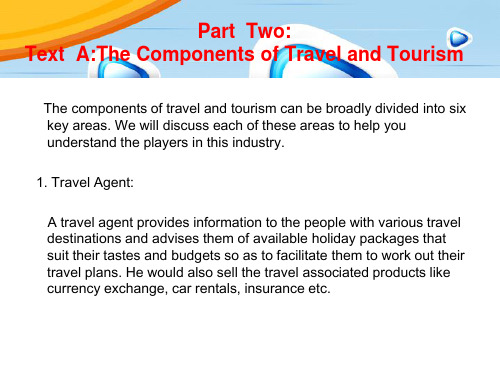
This component consists of those who provide accommodations to people in the form of hotels, resorts, apartments, camps, guesthouses etc. The accommodations may be marketed individually or through the tour operators in the form of package. Direct marketing may require huge costs on advertisements while sales through a tour operator may guarantee the occupancy rate throughout a holiday season. These service providers also take care of the catering needs of the people by providing them with huge cafeterias, various fast food outlets in house or in the form of a galleria.
(Adapted from Technofunc)
Part Three: Text B: A Brief History of Tourism
The history of tourism can be traced back to ancient years. As ancient world empires grew in Africa, Asia and the Middle East, the infrastructure necessary for travel such as land routes and water ways were created and vehicles and other means for travel were developed. During the Egyptian dynasties, travel for both business and pleasure began to flourish and hospitality centers were built along major routes and in the cities to accommodate travelers travelling between central government posts and outlying territories. At the height of the Assyrian empire, the means of travel were improved, the roads were improved, and markers were established to indicate distances and directions. Later, the Persians made further improvement to the road systems and developed four-wheeled carriages for transportation.
旅游翻译
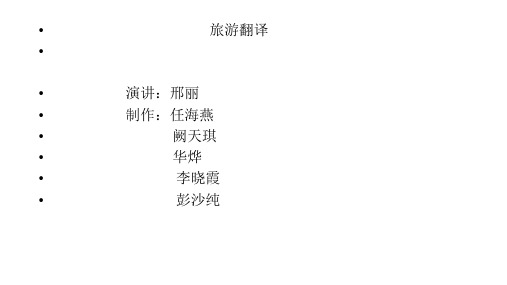
苏州位于沪宁线上,地处太湖之滨,建成于公元前415年,是我 国江南著名的古老城市之一。 Located on the Shanghai-Nanjing railway and off Lake Taihu, Suzhou is a city of historical fame south of the Yangtze, which claims its founding in 514 B.C.
城内外遍布名胜古迹。寒山寺,诗韵钟声,脍炙人口;虎丘,千年 古塔,巍然屹立;天平山,奇石嶙峋,枫林如锦;洞庭东山,湖光山色, 花果连绵。 The city abounds with fine scenery and historical interest. The popular haunt of Hanshan Temple, with its charming bell, has inspired many poetic mind. On Tiger Hill, a thousand-year-old pagoda stands in majesty; and while luxuriant fruit-trees add to the natural beauty of East Dongting Hills and lake around, Tianping Hill is featured by grotesque rock formations and red maple woods. •
• • • • • • • •
旅游翻译
演讲:邢丽 制作:任海燕 阙天琪 华烨 李晓霞 彭沙纯
北京作为世界旅游名城,有着极为丰富的旅游资源:雄伟壮丽的 天安门;金碧辉煌、气象万千的故宫;气势宏伟的万里长城;湖光 山色、曲栏回廊的颐和园;建筑精巧、独具艺术风格的天坛;烟波 浩渺、黛色风光的北海公园,以及建筑宏大的明代帝王陵寝——十三 陵……这些举世无双、驰名中外的古代建筑,历来是旅游者的竞游之 地。 [参考译文] Beijing, being one of the world’s great cities, is full of tourist attractions. Among these are the magnificent Tiananmen Gate, the majestic Palace Museum, the imposing Great Wall, the scenic Summer Palace, the ingenious Temple of Heaven, the enchanting Beihai Park and the carefully laidout Ming Tombs. Unrivaled and of world renown, these ancient structures remain attractions to both domestic and foreign travelers.
Module4 Unit 2 课件 2021-2022学年外研版英语八年级上册

3
4
1
2
Read and answer: • How many ways do I have to get from London to
Amsterdam? And which is the fastest way? Four. Flying is the fastest way. 2. How long does it take you from London to Amsterdam by coach? It takes you about twelve hours.
Words review
journey book park
outside
however cost
n. 旅行;旅程 v. 预订 v. 停放(车);泊(车) prep. 在……之外 adv. 在外面;朝户外 n. 外面;外部 adj. 外部的;外表的 adv. 然而;但是 v. 价钱为;花费 n. 价钱;成本;代价
Ways of travelling
coach plane train
Cost
£20 £80 £60
Time
10 hours 1 hour 3 hours
Comfortable
﹡ ﹡﹡ ﹡﹡﹡
Interesting
﹡﹡ ﹡
﹡﹡﹡
___Y_o_u_c_a_n__g_o_f_r_o_m__L_o_n_d_o_n__to__P_a_r_is__b_y___
by plane is the (6) _fa__st_e_s_t, but you need to go
to the airport. It also takes time.
不规则变化
当比较三个或三个以上的 事物时,可以用形容词的
旅游英语ppt课件

要点一
要点二
The Forbidden City
Located in the center of Beijing, it was a royal palace of the Ming and Qing dynasties in China and one of the largest palace complexes in the world.
Booking air tickets
Secure your air tickets online or through a travel agent to ensure a smooth journal
Arranging ground transportation
Plan your ground transportation to and from the airport, as well as within the destination city, to ensure effective travel
expressed as "Is there a guided tour available?"
Hotel check-in dialogue
Check in procedures, inquire about breakfast time, etc.
Restaurant dining conversation
04
Tourism and culturwill introduce the basic information of Western culture, including history, values, traditions, etc. It will help students understand the cultural background of the West and avoid cultural misunderstandings in tourism services
旅游英语ppt
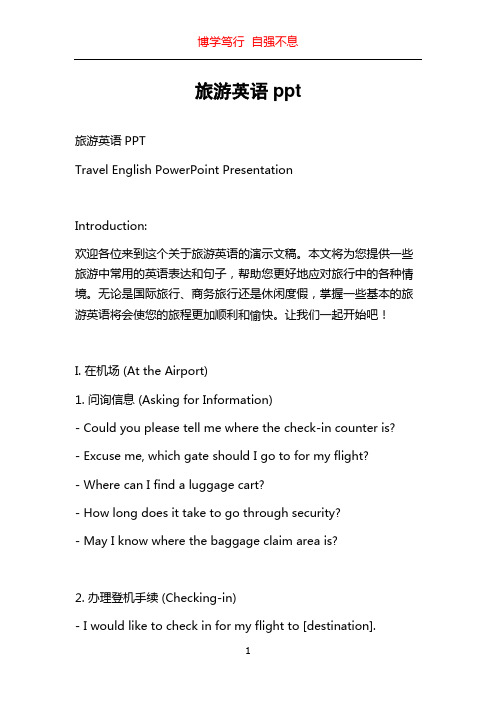
旅游英语ppt旅游英语PPTTravel English PowerPoint PresentationIntroduction:欢迎各位来到这个关于旅游英语的演示文稿。
本文将为您提供一些旅游中常用的英语表达和句子,帮助您更好地应对旅行中的各种情境。
无论是国际旅行、商务旅行还是休闲度假,掌握一些基本的旅游英语将会使您的旅程更加顺利和愉快。
让我们一起开始吧!I. 在机场 (At the Airport)1. 问询信息 (Asking for Information)- Could you please tell me where the check-in counter is? - Excuse me, which gate should I go to for my flight?- Where can I find a luggage cart?- How long does it take to go through security?- May I know where the baggage claim area is?2. 办理登机手续 (Checking-in)- I would like to check in for my flight to [destination].- Here is my passport and booking reference number.- How much baggage am I allowed to carry?- Can I have a window seat, please?- Is this the boarding pass and the gate number?3. 安全检查 (Security Check)- Please remove any metal objects from your pockets.- Could you place your bag on the conveyor belt, please? - Do I need to take off my shoes?- Are laptops and tablets allowed in the hand luggage? - Is there any liquid restriction for hand luggage?II. 在飞机上 (On the Plane)1. 问候和寒暄 (Greetings and Small Talk)- Good morning/afternoon/evening, welcome aboard. - Can I help you with your luggage?- Would you like a pillow or blanket?- Is this your first time flying with us?- How are you today? Enjoying your flight?2. 订购餐食 (Ordering Meals)- May I see the menu, please?- Do you have any vegetarian options?- Could you bring me a hot cup of coffee, please?- Is there a special meal for children?- What kind of beverages do you serve on this flight?3. 请求帮助 (Requesting Assistance)- Excuse me, could you please help me put my bag in the overhead compartment?- I'm feeling a bit airsick, can I have a glass of water?- My seatback TV is not working, could you fix it?- Would you mind turning down the air conditioning a bit?- Can I have an extra blanket, please?III. 在旅馆 (At the Hotel)1. 酒店预订 (Hotel Reservation)- I would like to make a reservation for a single/double room, please.- How much is the room rate per night?- Are there any discounts for group bookings?- Can I cancel my reservation without any charges?- Is breakfast included in the room rate?2. 前台办理入住 (Checking-in at the Front Desk)- Good evening, I have a reservation under the name of [your name].- Here is my identification and credit card.- Can you please provide me with a room key?- What time is the check-out? Can I have a late check-out?- Is there a wifi password I can use?3. 在客房的需求 (Requests in the Room)- The air conditioning seems to be not working properly, could you send someone to check?- Could you bring me some extra towels, please?- Is it possible to have a wake-up call at 7:00 am tomorrow?- Could you please provide me with an extra pillow?- I accidentally locked myself out of my room, can you help me?IV. 在旅途中 (During the Journey)1. 寻求帮助 (Seeking Help)- Excuse me, can you tell me where the nearest subway station is?- Is there a bus stop around here?- Could you please give me directions to the nearest pharmacy?- I seem to have lost my wallet, what should I do?- Do you know where I can find a good restaurant nearby?2. 向他人提问 (Asking Others)- Excuse me, do you know if there is a free WiFi hotspot?- Would you mind taking a picture of us, please?- Can you recommend any popular tourist attractions in this city?- Is there a local market where I can buy souvenirs?- Do you have any suggestions for affordable local restaurants?3. 议论旅行经验 (Discussing Travel Experiences)- This city is so beautiful, I'm glad I decided to come here. - The food in this country is amazing, I never want to leave.- The locals are so friendly and welcoming.- I had a great time exploring the historical sites in this city. - The weather here is perfect for outdoor activities.Conclusion:这个旅游英语的演示文稿希望能够帮助您在旅行中应对各种情境。
旅游英语
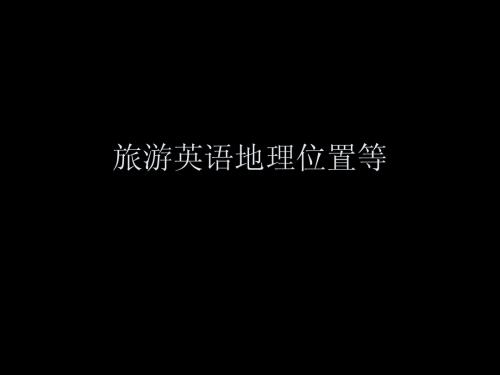
凡来上海游览的游客,导游无一例外地 会想他们介绍那座位于浦东陆家嘴金融贸易 区内高达468米的亚洲第一、世界第三的东方 明珠电视塔,它仅次于加拿大多伦多电视塔 (553米)和俄罗斯莫斯科电视塔(535米)。 对于上海人来说,巍巍耸立的东方明珠广播 电视塔的地位不啻于澳大利亚人民心中的悉 尼歌剧院和法国人心目中的埃国的首都, 城市 户籍人口为1107.5万,流动人口为300万。 北京人是北京的本地人口,其中最早 的历史可以追溯到50万年以前。历史资料 和考古发现都证明,北京作为一个城市已 经有3000多年的历史了。
Beijing, the capital of the People’s Republic of China, is populated with 11.075 million registered urban residents and 3 million urban migrants.
中心 at the heart of in the center of in the central part of • 发挥重要的作用; play the important role of occupy a very important position--• 由……组成 consist of be composed of
英译汉1: Elysee Palace
The Elysee Palace, with an area of 11,000 square meters, is at the eastern end of the Champs Elysee in the bustling city of Paris proper and backed by a large and tranquil gardern of more than twenty thousand square meters.
- 1、下载文档前请自行甄别文档内容的完整性,平台不提供额外的编辑、内容补充、找答案等附加服务。
- 2、"仅部分预览"的文档,不可在线预览部分如存在完整性等问题,可反馈申请退款(可完整预览的文档不适用该条件!)。
- 3、如文档侵犯您的权益,请联系客服反馈,我们会尽快为您处理(人工客服工作时间:9:00-18:30)。
信息添加
颐和园历史悠久,早在金朝时便是完颜亮的行 宫。
-
The Summer Place has a long history. It began to serve as a temporary palace as far back as the reign of Wanyan Liang(11501161), a ruler of the Jin regime(1115-1234).
-
后置重心转换为前置重心
在四川阿坝藏族自治州的南坪、松潘等县的交 界处,有一片纵深30余公里的风景区,那就是举 世闻名的大熊猫的故乡———九寨沟自然保护 区。
-
Jiuzhaigou,a 30-odd-kilometre-long scenic gully,lies on the border between Nanping and Songpan counties in the Aba Tibetan Autonomous Prefecture,Sichuan Province.It is the natural range of the world-known great panda,as well as a nature reserve designated by the state.
well-marked seasons with plenty of rainfalls and sunshine.
-
转化公式
1. Adj. + n. 上海就像一轮红日,光芒四射,鲜艳夺目。 Shine with boundless
radiance and brilliant color 2. adj. + to do (录音机)携带方便,操作简单convenient to carry and easy to operate 3. adj. +and + adj. (床垫)美观耐用,安全可靠 attractive and durable; safe and stable 4. adj. + prep. + n. (水果)色泽鲜艳,清香可口 beautiful in color and pleasant to the taste 5. sentence (茅台)历史悠久。誉满中外 Maotai enjoys a long history and a
-
分清主干,突出重点
乐山位于四川西南部,面积12826平方公里,人 口345万,是国内外旅游胜地之一。
-
(1)Leshan is located in the southwest of Sichuan Province and has an area of 12,826 square kilometers and a population of 3.45 million people. It is one of the famous tourist attractions both at home and abroad.
旅游类文章翻译
汉译英部分
-
要点概览
地名英译 篇章特点 四字结构
-
地名英译原则一
山西;陕西 渤海; 东海 长江;黄浦江
西湖;西湖风景区 中山陵;昭君墓;
鲁迅公园
Shanxi; Shaanxi
Bohai Sea;the East China Sea
the Yangtze River/ the Changjiang River;the Huangpu River
-
四字格
省略 转化
-
省略
在中国一提到孔子,上至白发苍苍的老人, 下至天真幼稚的顽童,无人不知,无人不晓。
Confucius is a household name throughout China.
本店货色齐全,品种多样,任君挑选。 We have a good assortment of goods to
choose from.
-
转化
这里山峦交错,峡谷相连,江水汹涌。 The valley is full of multi-peaked mountains,
joined canyons and turbulent waters. 这里气候温和,四季分明,雨量充沛,日照
充足。 The place enjoys a temperate climate with
the West Lake; the Xihu Scenic Area
Dr. Sun Yat-Sen’s Mausoleum; thБайду номын сангаас Tomb of Wang Zhaojun;Lu Xun Park
-
地名英译原则二
规范:Peking vs. Beijing 统一: Li River/ Lijiang River; Mount E’mei/Mt.
E’mei/ the E’mei Mountain 音义兼顾:象鼻山 Xiangbi Hill or the
Elephant-Trunk Hill; 独秀峰Duxiu Peak or Unique Beauty Peak
-
篇章特点
分清主干,突出重点 后置重心转换为前置重心 信息添加 灵活变通
(2)Located in the southwest of Sichuan Province, Leshan is one of the famous tourist attractions both at home and abroad, with an area of 12,826 square kilometers and a population of 3.45 million people.
-
灵活变通
满树金花、芳香四溢的金桂;花白如雪、香气 扑鼻的银桂;红里透黄、花多味浓的紫沙桂;花 色似银的四季桂;竞相开放,争艳比美。进入桂 林公园,阵阵桂香扑鼻而来 。
-
The Park of Sweet Osmanthus is noted for its profusion of different kinds of osmanthus trees. They are all in full bloom with flowers in different colors, which pervade the whole garden with fragrance.
